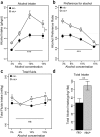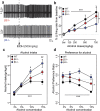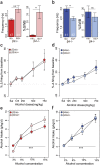Nicotine enhances alcohol intake and dopaminergic responses through β2* and β4* nicotinic acetylcholine receptors
- PMID: 28332590
- PMCID: PMC5362818
- DOI: 10.1038/srep45116
Nicotine enhances alcohol intake and dopaminergic responses through β2* and β4* nicotinic acetylcholine receptors
Abstract
Alcohol and nicotine are the most widely co-abused drugs. Both modify the activity of dopaminergic (DA) neurons of the Ventral Tegmental Area (VTA) and lead to an increase in DA release in the Nucleus Accumbens, thereby affecting the reward system. Evidences support the hypothesis that distinct nicotinic acetylcholine receptors (nAChRs), the molecular target of acetylcholine (ACh) and exogenous nicotine, are also in addition implicated in the response to alcohol. The precise molecular and neuronal substrates of this interaction are however not well understood. Here we used in vivo electrophysiology in the VTA to characterise acute and chronic interactions between nicotine and alcohol. Simultaneous injections of the two drugs enhanced their responses on VTA DA neuron firing and chronic exposure to nicotine increased alcohol-induced DA responses and alcohol intake. Then, we assessed the role of β4 * nAChRs, but not β2 * nAChRs, in mediating acute responses to alcohol using nAChR subtypes knockout mice (β2-/- and β4-/- mice). Finally, we showed that nicotine-induced modifications of alcohol responses were absent in β2-/- and β4-/- mice, suggesting that nicotine triggers β2* and β4 * nAChR-dependent neuroadaptations that subsequently modify the responses to alcohol and thus indicating these receptors as key mediators in the complex interactions between these two drugs.
Conflict of interest statement
The authors declare no competing financial interests.
Figures




Similar articles
-
Menthol Alone Upregulates Midbrain nAChRs, Alters nAChR Subtype Stoichiometry, Alters Dopamine Neuron Firing Frequency, and Prevents Nicotine Reward.J Neurosci. 2016 Mar 9;36(10):2957-74. doi: 10.1523/JNEUROSCI.4194-15.2016. J Neurosci. 2016. PMID: 26961950 Free PMC article.
-
β4-Nicotinic Receptors Are Critically Involved in Reward-Related Behaviors and Self-Regulation of Nicotine Reinforcement.J Neurosci. 2020 Apr 22;40(17):3465-3477. doi: 10.1523/JNEUROSCI.0356-19.2020. Epub 2020 Mar 17. J Neurosci. 2020. PMID: 32184221 Free PMC article.
-
Role of β4* Nicotinic Acetylcholine Receptors in the Habenulo-Interpeduncular Pathway in Nicotine Reinforcement in Mice.Neuropsychopharmacology. 2016 Jun;41(7):1790-802. doi: 10.1038/npp.2015.346. Epub 2015 Nov 20. Neuropsychopharmacology. 2016. PMID: 26585290 Free PMC article.
-
Cortical control of VTA function and influence on nicotine reward.Biochem Pharmacol. 2013 Oct 15;86(8):1173-80. doi: 10.1016/j.bcp.2013.07.013. Epub 2013 Aug 7. Biochem Pharmacol. 2013. PMID: 23933294 Review.
-
Neural circuits and nicotinic acetylcholine receptors mediate the cholinergic regulation of midbrain dopaminergic neurons and nicotine dependence.Acta Pharmacol Sin. 2020 Jan;41(1):1-9. doi: 10.1038/s41401-019-0299-4. Epub 2019 Sep 25. Acta Pharmacol Sin. 2020. PMID: 31554960 Free PMC article. Review.
Cited by
-
Alcohol Interaction with Cocaine, Methamphetamine, Opioids, Nicotine, Cannabis, and γ-Hydroxybutyric Acid.Biomedicines. 2019 Mar 7;7(1):16. doi: 10.3390/biomedicines7010016. Biomedicines. 2019. PMID: 30866524 Free PMC article. Review.
-
Advice for smokers in smoking cessation clinic: a review.Afr Health Sci. 2023 Jun;23(2):374-379. doi: 10.4314/ahs.v23i2.42. Afr Health Sci. 2023. PMID: 38223627 Free PMC article. Review.
-
Chronic nicotine increases midbrain dopamine neuron activity and biases individual strategies towards reduced exploration in mice.Nat Commun. 2021 Nov 26;12(1):6945. doi: 10.1038/s41467-021-27268-7. Nat Commun. 2021. PMID: 34836948 Free PMC article.
-
Restoration of MPTP-induced Dopamine and Tyrosine Hydroxylase Depletion in the Mouse Brain Through Ethanol and Nicotine.Neurotox Res. 2025 Feb 12;43(1):9. doi: 10.1007/s12640-025-00732-8. Neurotox Res. 2025. PMID: 39937382
-
Chronic Nicotine Exposure Initiated in Adolescence and Unpaired to Behavioral Context Fails to Enhance Sweetened Ethanol Seeking.Front Behav Neurosci. 2017 Aug 17;11:153. doi: 10.3389/fnbeh.2017.00153. eCollection 2017. Front Behav Neurosci. 2017. PMID: 28860980 Free PMC article.
References
Publication types
MeSH terms
Substances
LinkOut - more resources
Full Text Sources
Other Literature Sources
Molecular Biology Databases

